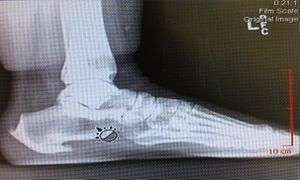Calcaneal spur
| Calcaneal spur | |
|---|---|
 | |
| A radiograph showing osteophyes on the posterior and inferior aspects of the left calcaneus | |
| Classification and external resources | |
| Specialty | rheumatology |
| ICD-10 | M77.3 |
| ICD-9-CM | 726.73 |
| DiseasesDB | 10467 |
| MeSH | D036982 |
A calcaneal spur (or heel spur) is a small osteophyte (bone spur) located on the calcaneus (heel bone). Calcaneal spurs are typically detected by a radiographic examination (commonly referred to as an "x-ray").
When a foot bone is exposed to constant stress, calcium deposits build up on the bottom of the heel bone. Generally, this has no effect on a person's daily life. However, repeated damage can cause these deposits to pile up on each other, causing a spur-shaped deformity, called a calcaneal (or heel) spur. Obese people, flatfooted people, and people who often wear high-heeled shoes are most susceptible to heel spurs.
An inferior calcaneal spur is located on the inferior aspect of the calcaneus and is typically a response to plantar fasciitis over a period, but may also be associated with ankylosing spondylitis (typically in children). A posterior calcaneal spur develops on the back of the heel at the insertion of the Achilles tendon.
An inferior calcaneal spur consists of a calcification of the calcaneus, which lies superior to the plantar fascia at the insertion of the plantar fascia. A posterior calcaneal spur is often large and palpable through the skin and may need to be removed as part of the treatment of insertional Achilles tendonitis.[1] These are also generally visible to the naked eye.[2]
Signs and symptoms

Major symptoms consist of pain in the region surrounding the spur, which typically increases in intensity after prolonged periods of rest. Patients may report heel pain to be more severe when waking up in the morning. Patients may not be able to bear weight on the afflicted heel comfortably. Running, walking, or lifting heavy weight may exacerbate the issue.
Treatment
Many treatment options exist, and good results are often observed. Generally, a calcaneal spur develops when proper care is not given to the foot and heels. It is often seen as a repetitive stress injury, and thus lifestyle modification is typically the basic course of management strategies.
To alleviate heel spur pain, a person should begin doing foot and calf workouts. Strong muscles in the calves and lower legs will help take the stress off the bone and thus help cure or prevent heel spurs. Icing the area is an effective way to get immediate pain relief.[3]
References
- ↑ "Primary Care Question Answering Service", National Library for Health (NLH), National Health Service
- ↑ http://heel-spur.net/
- ↑ http://www.wikihow.com/Get-Rid-of-Heel-Spurs
External links
| Wikimedia Commons has media related to Calcaneal spur. |